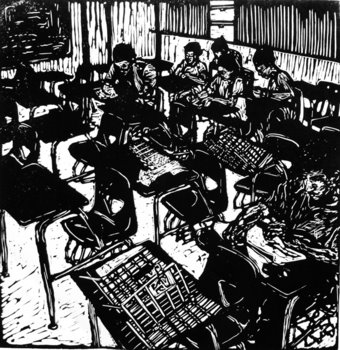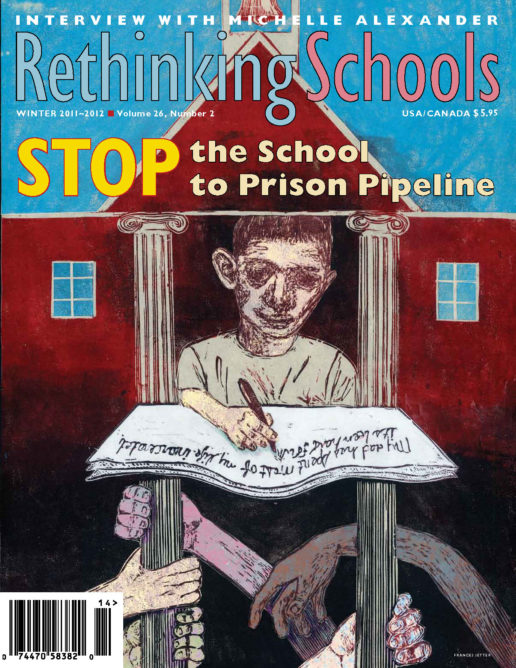Teaching Haniyah
Illustrator: Thea Gahr

Several years ago, I taught a unit on power in my 9th-grade social studies classes at Berkeley High School in California’s Bay Area. It’s a diverse school—rich folks from the hills, middle- and working-class from the flats; about one-third each of African American and white students; the other third a combination of Latina/o, multi-ethnic, South Asian, and others.
For our initial activity, I asked students to interview someone—a relative, neighbor, or themselves—about an encounter with the police. I emphasized that it could be any kind of contact, positive or negative. The questions were basic: Where were you and what were you doing when the encounter began? What did the police do and say? What was the result? How did it make you feel?
The next day, I had the students tell their stories in small groups. Then we rotated the groups so each student ended up hearing everyone else’s story. After we returned our desks to a large circle, I asked the students: What did you hear? What does it make you think?
The results were stark. As Valerie, a Filipina student, said: “At least in terms of the cops, there are two realities happening in the same city, one for white kids, one for everyone else.” To be sure, some white students told stories of being hassled for skateboarding or followed in stores, but there were also stories of lost children reunited with their families and of petting police horses in the park. Among the African American, Latina/o, and Muslim students, the stories piled up of being stopped while walking down the street, thrown against walls, and frisked; immigration agents breaking into apartments; visits to older brothers and other relatives in prison. I was stunned by how sharp the differences were. I was also surprised by the level of openness in the room. The students with painful stories were eager to share them, and the other students were interested and supportive.
One student wrote in a reflection on the activity: “My brother is in jail, and it makes everyone in my family upset. But I never talk about it at school or with my friends. That makes it even worse.” Like Haniyah, many of my students of color were describing the impact of the criminal justice system on their families and communities. They were also describing their own fears and vulnerability to getting trapped in the school-to-prison pipeline, and their need to have school be a place to share, analyze, and put their experience in a broader context.
As Haniyah so clearly describes, having a parent or loved one caught up in the criminal justice system is an ongoing crisis that affects every aspect of family life. In many communities, we are in essence teaching in war zones. In California, for example, as you travel through the Central Valley, virtually every freeway exit accesses an institution where people are locked up. Some of us have spent way too much time in or visiting prisons; others have no idea that we are surrounded by people who are incarcerated. Nationally, more than 7 million children have a parent caught up in the criminal justice system.
As teachers we need to understand what is happening so we can provide support. One source of information is programs like the one that Haniyah participated in. Project WHAT! provides leadership development and paid jobs to youth with incarcerated family members. The young people connect their own experiences to the skills and information they need to lead workshops for teachers, social workers, probation and parole officers. They hope to raise awareness and improve services and policies that affect children with incarcerated parents.
“It’s enormously helpful if teachers look for context, if they realize that a child might be acting out because of something big that happened at home,” according to former director of Project WHAT! Anna Wong. “Maybe they witnessed someone in their family getting arrested. Maybe they went to visit a sibling in jail and were denied a visit. You never know if you don’t ask.”
Mailee Wang is the current program and policy director. Both of her parents were arrested and incarcerated when she was a teenager. “In my case, it was in the newspapers, so everyone knew, but no one talked to me about it. I felt like an outcast. The teachers were judging me, but no one acknowledged that I was going through really tough times.” She ended up being expelled from school. But, Wang says, supportive teachers and other adults can make an enormous difference. Participant Brynesha Williams explains:
I was at school talking to a friend in the lunchroom about how I found out my mom went back to jail. I started crying and right then a lady who was walking by noticed me and stopped. Most teachers wouldn’t stop if they saw a student crying, but she did. I didn’t know her at all. I just saw a very tall, light-skinned woman in her 40s with a kind face. “Why are you crying?” she said. I told her, “My mom’s back in jail.” She introduced herself as Ms. Boone, the health coordinator, and asked if I wanted to come talk to her. I could tell she had a good spirit, so I went and told her about the whole situation.
Ms. Boone made herself available to talk whenever Brynesha was upset, found her a girls’ group and tutoring, and eventually helped her re-establish contact with her mother inside.
‘Felon’ Is Not an Identity
The relationship to loved ones in prison is a central and vulnerable issue for many of these students. One of the most important lessons Haniyah teaches us lies in her description of her father. He emerges as a complex person—someone with enormous strengths and gifts as well as weaknesses, someone whose own initial contact with the criminal justice system happened when he was far too young and far too vulnerable.
Haniyah loves and admires her father while recognizing how his mistakes have affected her life. The same is true for many of our students whose parents are incarcerated. They need our support in recognizing the significance of their parents in their lives. The mass incarceration that is destroying the fabric of our society rests on stereotyping those in prison as worthless, as if “felon” were a fullblown character description. This puts children with incarcerated parents or siblings in a terrible psychological bind. That bind is exacerbated by the silence, even in the most affected communities, about how many people are locked up. Michelle Alexander explains:
Mass incarceration, far from reducing the stigma associated with criminality, actually creates a deep silence in communities of color, one rooted in shame. Imprisonment is considered so shameful that many people avoid talking about it, even within their own families. . . . Even in communities devastated by mass incarceration, many people struggling to cope with the stigma of imprisonment have no idea that their neighbors are struggling with the same grief, shame, and isolation. . . . Even in church, a place where many people seek solace in times of grief and sorrow, families of prisoners often keep secret the imprisonment of their children or relatives. As one woman responded when asked if she could turn to church members for support, “Church? I wouldn’t dare tell anyone at church.” (161)
What Can Teachers Do?
When my daughter was in elementary school, a friend of ours, Donna Wilmott, was in federal prison for several years, and her daughter Zoe and husband lived with us. When Zoe’s teacher, Marilyn Garcia, found out that Donna was at a prison an hour away, she applied to be on Donna’s visiting list. Then she went to the prison to have a parent/teacher conference in person. She corresponded with Donna, sending her a class photo and examples of Zoe’s work. Not everyone has the time, resources, and generosity of spirit to do all of that, but the impact on both Donna and Zoe was immeasurable.
The first step is to break the silence. Each fall I teach, I look for a way tomention that people I love have been in prison for many years, and that I visit them regularly. Other teachers will have different ways of opening up the subject, using poetry, fiction, news articles, or videos.
Wang offers some guidelines for teachers:
- Don’t judge, blame, or label the child because their family member is incarcerated.
- Don’t treat the child as though their parent’s incarceration is a reflection on them.
- Don’t project any feelings you have about incarcerated people onto the child.
- Don’t ask why their family member is incarcerated. The details aren’t important.
- Don’t assume that the child thinks poorly of their incarcerated parent.
- Treat them as you do every other student, believe in them, and let them know they are worthy of success.
The next step is to develop and teach curriculum about the criminal justice system that supports all our students in thinking critically and deeply. In the same way that there are developmentally appropriate ways to engage even young children in discussions of war, immigration, and other critical current issues, we need to create the context and support for our students to grapple with the realities of “law and order.” Mass incarceration is affecting many, many of our students, and we need to shine the light of social justice teaching and critical thinking on the issues.
The final and most important step is to fight—in our schools, neighborhoods, states, and nation—to stop the criminalization and incarceration of our students and their families.
References
Alexander, Michelle. The New Jim Crow: Mass Incarceration in the Age of Colorblindness. New York: The New Press, 2010.
Project WHAT! Resource Guide for Teens with a Parent in Prison or Jail. Berkeley, Calif.: Communityworks, 2008.

